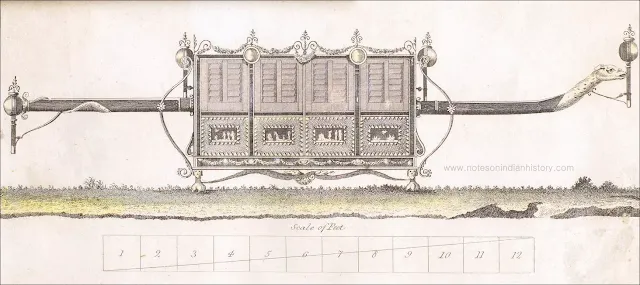Description of Palanquins Presented to Tipu's Sons by Lord Cornwallis
Steuart & Co. Coachmakers in Calcutta were specialized in embroidering palanquins for the native princes of India.
Their exceptional craftsmanship was evident in the two state palanquins they built for Marquis Cornwallis, upon his order, for Tipu Sultan's sons Abdul Khaliq and Muiz-ud-din. These palanquins were commissioned while the princes were held hostage by the British in Madras, following Tipu Sultan's defeat in the 3rd Anglo-Mysore war. The palanquins were valued at an impressive Rs. 6 or 7000.
The European Magazine of 1796 provides a detailed description of the palanquin, which is as follows:
These state palanquins were executed in the most costly and magnificent style. All the moldings round the framing were solid silver highly polished and of the most exquisite workmanship. On the extremities of the bamboos were heads of various animals elegantly embossed and engraved, to represent life; and the panels exhibited on the different compartments various trophies of war, to accord with the taste of that warlike prince (Tipu Sultan). They were lined with rich crimson velvet, on which trophies of war, and other ornaments, were magnificently embroidered with gold bullion lace.
The palanquins were presented to the young princes in the absence of Lord Cornwallis by Lady Oakley, the wife of Charles Oakley, the Governor of Madras. Captain Doveton escorted the princes to Srirangapatna and presented the palanquins during his audience with Tipu Sultan. Tipu Sultan remarked, "I admire them much, but where true friendship exists, a present is but a form."
However, after Tipu's death in the 4th Anglo-Mysore war, the British looted his treasury and discovered the palanquins untouched and still in their original packaging.
Steuart & Co. Coachmakers became famous and had soon afterwards orders for state palanquins from the Nawabs of Arcot and Lucknow, as well as many other native princes.
Their exceptional craftsmanship was evident in the two state palanquins they built for Marquis Cornwallis, upon his order, for Tipu Sultan's sons Abdul Khaliq and Muiz-ud-din. These palanquins were commissioned while the princes were held hostage by the British in Madras, following Tipu Sultan's defeat in the 3rd Anglo-Mysore war. The palanquins were valued at an impressive Rs. 6 or 7000.
The European Magazine of 1796 provides a detailed description of the palanquin, which is as follows:
 |
| Side view of the Oriental style palanquin, with four shutters and four panels to the viewer, a pole with animal-head shaped top to right; below image, a scale of feet from 1 to 12 - British Museum |
These state palanquins were executed in the most costly and magnificent style. All the moldings round the framing were solid silver highly polished and of the most exquisite workmanship. On the extremities of the bamboos were heads of various animals elegantly embossed and engraved, to represent life; and the panels exhibited on the different compartments various trophies of war, to accord with the taste of that warlike prince (Tipu Sultan). They were lined with rich crimson velvet, on which trophies of war, and other ornaments, were magnificently embroidered with gold bullion lace.
The palanquins were presented to the young princes in the absence of Lord Cornwallis by Lady Oakley, the wife of Charles Oakley, the Governor of Madras. Captain Doveton escorted the princes to Srirangapatna and presented the palanquins during his audience with Tipu Sultan. Tipu Sultan remarked, "I admire them much, but where true friendship exists, a present is but a form."
However, after Tipu's death in the 4th Anglo-Mysore war, the British looted his treasury and discovered the palanquins untouched and still in their original packaging.
Steuart & Co. Coachmakers became famous and had soon afterwards orders for state palanquins from the Nawabs of Arcot and Lucknow, as well as many other native princes.


Comments